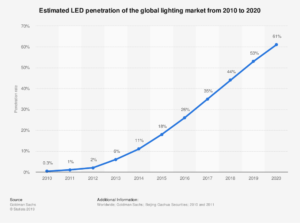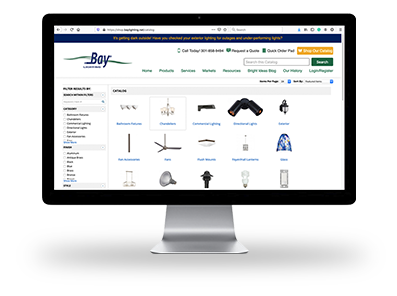Blog
- Home
- Resources
- Bright Ideas Blog
- LED Technology: An Overview
LED Technology: An Overview
What is LED technology?
In recent years, light-emitting diode (LED) lighting has exploded in popularity. You’ve most likely seen LED lights somewhere – they’ve become a popular choice for car headlights, parking lots, decorations, signs, and exhibits. They’re recognizable by their brightness and ability to illuminate spaces closest to how they appear in natural light.
The chart below illustrates the results of a Goldman Sachs study which predicts LED technology will account for 61% of the global lighting market by 2020. This is based on skyrocketing popularity since the beginning of the decade, at which point it was a mere 0.3%.
With all of the benefits of LED lighting, the increase in LED popularity of no surprise.
Here are some fast facts about LED lighting:
- LEDs, or light emitting diodes, burn light 90% more efficiently than standard incandescent bulbs.
- LEDs generally last between 12 and 22 years. That’s a lot of savings on replacement bulbs!
- When used consistently, LEDs can save 348 TWH of power in 15 years. That’s enough to power 44 electrical plants!
- We all know bugs are attracted to incandescent bulbs, which can make for a really unpleasant doorway space or back porch. LEDs actually keep bugs away! They don’t use the level of ultraviolet light and infrared radiation that draws in the pests.
- LEDs are safer – they only reach 140 degrees Fahrenheit, so they won’t burn you when you touch them. Other bulbs can reach up to 700 degrees.
- LEDs don’t contain mercury, unlike CFL and incandescent bulbs.

- If you drop an LED light fixture, it’s probably not going to shatter into a thousand pieces. They are not easily damaged by external shock.
- When used in food displays, it has been proven to breed less bacteria than other types of lighting.
- Some modern 1LED lights can last 100,000 hours!
- The U.S Department of Energy estimates that the adoption of LEDs in residential and commercial spaces will save consumers $265 billion and prevent the need for 40 more power plants.
- 100% of the energy used to power LED lights is converted into light. A common bulbs only converts 10%. That translates to a big waste of power and drain on your bank account!
The History of LEDs
While the development of LED technology began in 1907, the first LED lights for commercial use began circulating in 1994. Up until that point, they were much too expensive to manufacture for regular consumers to buy.
Even at that point, LEDs were very expensive, at around $200 per piece. Today, they are much more affordable, and are used regularly in commercial, industrial, and residential spaces.
What are the different types of LED lighting?
- Color – LED bulbs emit light in warm white, cool white, and daylight color, which is a stark white with a tinge of blue. Each color is used for different applications; warm white for homes, cool white for shops and offices, and daylight for outdoor applications and real color.
- Dimmable – LEDs can be controlled with dimmer switches so that the light can be customized to your exact liking.
Is LED lighting good for the environment?
LED bulbs use a lot less energy than incandescent and fluorescent lights (CFLs). As previously mentioned, they convert 100% of the energy used to power them to light, eliminating the massive energy waste of traditional bulbs.
Since LED technology consumes less power, the result is a significant reduction in greenhouse gas emissions from power plants. In fact, it is estimated that one LED bulb will minimize emissions by almost half a ton.
Since LED bulbs last so much longer, they need to be replaced a lot less. That means less manufacturing waste, and less physical waste! Depending on their specifications, an LED bulb will burn between 25,000 to 50,000 hours. That’s compared to incandescent bulbs at 1,200 and CFLs at 8,000.
The following are some other environmental benefits of switching to LED lighting.
- Since LEDs last so long and don’t need to be replaced often, there is a reduction in manufacturing pollution, such as shipping, disposal, sale, and production waste.
- LEDs don’t burn fossil fuels, which results in less air pollution.
- LEDs don’t contain toxic substances like mercury, which can pose a major hazard for factory workers and others who handle bulbs.
- While traditional bulbs emit ultraviolet radiation, this need is completely eliminated in operating LEDs. UV radiation is known to damage skin cells and can increase the risk of cancer. It can also inhibit the growth of plants.
- LEDs emit very little carbon. If you’re looking to reduce your carbon footprint, switching to LED lighting will have a major impact.
Where can I install LED lighting?
LEDs are no longer the most expensive lighting option. With the help of an LED lighting supplier, anyone can fit their space with LEDs, whether it’s residential, commercial, or industrial. These bulbs offer more clarity and incomparable illumination quality. This makes them a great choice for outdoor and underground areas, where it’s especially important to feel safe and aware of your surroundings.
Some common uses for LED bulbs include;
- Parking garages
- Elevators
- Bars/nightclubs
- Jewelry cases
- Restaurants
- Staircase lighting
- Storefront displays
- Vehicle headlights and interiors
- Gallery spaces (no harmful UVs to damage artwork!)
- Backyard/patio/deck lighting
- Under/over cabinets
- Holiday lighting
LEDs are the best choice for spaces in which good, clear lighting is priority. Some buildings require different lighting than others. Dimmable mood lighting might be the right choice. It might also be clear, bright illumination to prevent injury and promote safety. Every space is different – it’s best to consult an LED lighting company to discuss your specific needs.
Will switching to LED technology save me money?
Upgrading to LED lighting for your residential, commercial, or industrial space is a great way to save money. While it might be a bit of an investment initially, the savings will certainly be reflected in your monthly energy bill.
LED bulbs need to be changed much less often than CFLs and incandescents. That means less purchasing new bulbs and less maintenance dedicated to changing these bulbs! Since they consume significantly less power than traditional light fixtures, that equals reduced energy and less spending by your. Imagine the amount you could save on a building that needs to be lit 24/7 or for a significant portion of the day.
Contact Us
If you’re interested in switching to LED lighting or just want to know more about LED technology, don’t hesitate to contact Bay Lighting. As a DC, Maryland, and Virginia commercial lighting distributor, we prioritize educating and guiding our customers in making the best lighting choices for their facility. Contact us at 301-858-9494 to speak with a lighting consultant today.




